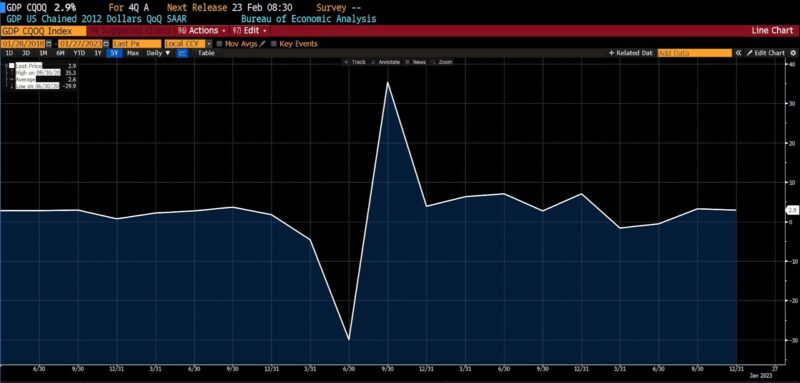Real GDP rose 2.9 percent in the 4th quarter of 2022, exceeding estimates ranging from 2.6 to 2.7 percent. This puts the first estimate of overall US economic growth in 2022 at 2.1 percent. While this is notable in light of the brief recession that took place earlier in the year and the aggressive rate hikes undertaken by the Federal Reserve, that growth rate is roughly one-third of real US GDP growth in 2021 (5.7 percent).
Real US GDP 4th qtr (2018 – present)

Personal consumption growth slowed to 2.1 percent from 2.3 percent in the prior quarter, with positive spending on goods, particularly vehicles and vehicle parts. Personal care services, healthcare, housing and utilities led spending on services. Of particular note, final sales to private domestic purchasers rose 0.2 percent in the 4th quarter, a steep decline from the 2.1 percent levels of the first quarter of 2022.
Residential investment declined sharply, down 26.7 percent in the quarter. Mortgage applications fell by 51%, as conditions characterized by rising mortgage rates and a tightening supply of housing prevail. The average 30-year mortgage rate recently fell back below 7 percent.
Business investment dropped 3.7 percent, as respondents to various surveys became increasingly pessimistic. Inflation, rising interest rates, and uncertainty regarding near-term economic growth are leading firm owners and entrepreneurs to postpone expansion plans.
Inventories and trade added to overall GDP growth by 2 percent. The trade contribution to the top line is questionable as an indication of growth owing to falling imports versus rising exports. Similarly, higher inventories have a questionable significance. If growing because businesses expect future consumption, they arguably suggest future growth prospects. In conjunction with softening consumer spending, declining business optimism, and increasing strain on households, rising inventories may suggest slackening demand.
The Fed tightening cycle is likely approaching a pause, but as money supply growth has turned negative and both consumer and business confidence decline, economic fundamentals are softening. American consumers, additionally, are working through the last remnants of the excess savings associated with pandemic stimulus programs. Caution is warranted.
THIS ARTICLE ORIGINALLY POSTED HERE.




